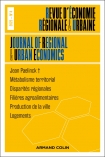
REVUE D'ÉCONOMIE RÉGIONALE ET URBAINE (5/2022)
Pour acheter ce numéro, contactez-nous
Recevez les numéros de l'année en cours et accédez à l'intégralité des articles en ligne.
Cette note de recherche documente l’influence de l’État central dans l’orientation géographique des investissements immobiliers. Depuis 2009, les aides fiscales à l’investissement locatif des ménages (actuel dispositif Pinel) ne sont disponibles que sur une part de plus en plus restreinte du territoire national. Le recul des périmètres d’éligibilité à ces dispositifs, mis en place par étape, s’accompagne d’une augmentation de leur poids budgétaire global. Il résulte de cette politique une concentration géographique des aides à l’investissement immobilier des ménages dans les zones où la demande locative est estimée suffisante. Ce fléchage géographique des aides semble répondre à une volonté des décideurs publics de protéger la rentabilité des investissements locatifs des ménages en les canalisant vers les zones dites tendues où la demande locative est plus forte. Les résultats présentés soulignent l’intérêt d’une étude des formes géographiques de la régulation des marchés du logement.
This paper looks into the connections between housing production, public policies and household wealth accumulation. It argues that institutional forms of regulation should be considered through a geographical lens. Relying on the study of place-based rental investment tax subsidies for households in France, the main argument is that despite the decline of Fordism, the central State remains very influential in channeling the rental investments of households to specific geographical areas. While households benefitting from tax subsidies financed around a third of new French multifamily housing during the 2000s, the eligible areas for this scheme have been significantly reduced since 2009. Although this tax incentive is commonly acknowledged as a pillar of housing production regulation, little attention has been paid to its geographical dimension. This paper shows how the progressive reduction of the areas eligible for these schemes has gone hand in hand with an increase in their overall budgetary weight. In 2009, the tax rebate was available throughout the country and cost around 0.59 billion euros. In 2018, only 6.4 % of French municipalities were eligible for the scheme, for a loss in tax revenue of over 2.1 billion euros. The geographical concentration of these subsidies has targeted high demand areas (metropolitan, coastal or cross-border municipalities). Drawing on an examination of grey literature and minutes from National Assembly debates, the paper argues that this geographical targeting stems from the desire of policymakers to protect the profitability of household investments. Finally, it suggests that by constructing rental housing as a low-risk, subsidised investment for households, policymakers are likely to foster the "rentierization" (Christophers, 2019) of the French housing economy.

